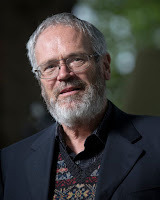by Andrew Greig
 Long after Sir Edmund Hillary and Tenzing Norgay reached the summit of Mount Everest in 1953, the northeast ridge route seemed unconquerable.
Long after Sir Edmund Hillary and Tenzing Norgay reached the summit of Mount Everest in 1953, the northeast ridge route seemed unconquerable.
Before the summit can be reached on this route, climbers must get past the notoriously dangerous Three Pinnacles.
At 25,590, 26,574 and 26,902 feet above sea level respectively, these rock formations require skillful technical climbing as climbers try to survive in the death zone.
This is the route used by pioneering British climbers George Mallory and Andrew “Sandy” Irvine in 1924, and by veteran British climbers Joe Tasker and Peter Boardman in 1982. All four disappeared during their attempts. Mallory and Irvine left behind the mystery of whether or not they had summited. Peter Boardman’s body was found by Japanese climbers in 1992. Tasker’s camera bag was found in 1985 by climbers on the expedition described in this book.
Author Andrew Greig takes readers from expedition leader Malcolm Duff’s first conception of the expedition through the gathering of climbers, sponsors, funding and equipment to the alternately awe-inspiring and spirit-destroying moments of climbing the mountain.
Duff believed that if the team carried oxygen to use through the Pinnacles to the summit, they would succeed. Ultimately they did not due to bad weather, health and acclimatization problems, radio communication issues and the logistical challenges of the mountain itself.
As a result, Greig’s story of the expedition is not the drama of a hard-fought victory of man against mountain, nor one of tragic failure that many other famous mountaineering books tell.
He does give armchair adventurers a close view of a mountaineering expedition, from the challenges of creating a working team from 19 competitive men who don’t know each other well to the tensions within climbers about saving their physical resources for a summit attempt versus committing to work for the good of the expedition.
Any dangerous mountaineering expedition is a blend of teamwork and self-mastery.
As lead climber Jon Tinker pointed out, “You don’t necessarily have to be much of a climber to go to 8,000 metres (26,246-feet), but you do need uncommon endurance, persistence, judgment and nerve. And luck. It’s a test of character as much as of the body, mere physical fitness seems to have little to do with it.”
Although this expedition didn’t conquer the northeast ridge to reach the summit of Everest, all the members survived. That is no small feat on Everest’s 29,028-foot summit, where one out of every four people who try don’t come back. (In fact the following year, Julie Tullis, a climber and part of the film crew recording the Duff expedition, went missing coming down from the summit of K2 in a storm. Duff himself died in his sleep at Everest Base Camp of an apparent heart attack in April 1997 while leading a Scottish commercial expedition. He was 43.)
It would take another 10 years after Duff’s attempt on the northeast ridge before mountaineers successfully reached the summit on that route. In 1995, a Japanese university team, supported by 35 high-altitude porters, climbed the ridge, including the Three Pinnacles, to reach the summit.
One of the most interesting parts of the book is a section where participants talk about what the expedition meant to them. Dave Bricknell, executive with Pilkington Brothers PLC, the expedition sponsor, said that when he returned “so many people said ‘it must have been the experience of a lifetime.’ Not so. It was an experience of a lifetime, a tremendous emotional experience to store and treasure with such memories as watching the birth of my children, signing my first major company deal, finishing my first marathon and passing my law finals, but it didn’t overwhelm them.”
He added that while he hoped it was not the climax of his life, it did leave him grateful for the opportunity to have had the experience.
In the end, as Greig observed, “Everest is as much a myth as a mountain, this place is full of ghosts.”
If you’re interested in books on mountain climbing you might be interested in Buried in the Sky: The Extraordinary Story of the Sherpa Climbers on K2’s Deadliest Day; Fragile Edge about writer Maria Coffey’s relationship with Joe Tasker; or Where the Mountain Casts Its Shadow; the Dark Side of Extreme Adventure, also by Coffey that examines the cost to families and loved ones when a climber dies during an expedition.
The Author: Andrew Greig (1951 – )
Poet, novelist and climber Andrew Greig published an account of the successful ascent of the Muztagh Tower, Summit Fever: The Story of an Armchair Climber, which was shortlisted for the 1996 Boardman Tasker Prize for Mountain Literature.
His work on that expedition and his writing ability earned him a place in Malcolm Duff’s 1985 Northeast Ridge expedition.
His days of climbing in the Himalayas ended due to illness, but by that time he’d turned to writing novels, first Electric Brae (1992) and then The Return of John MacNab (1996). The first was shortlisted for the McVitie’s Prize for Scottish Writer of the Year; the second was shortlisted for the Romantic Novelists’ Association Award.
His 1999 book When They Lay Bare was inspired by two dreams and an old ballad. A life-threatening illness lead him to write about love in the time of war, a novel set in the summer of 1940 titled That Summer (2000). His fifth novel, In Another Light (2004), set in Penang and Orkney, won the Saltire Society Scottish Book of the Year Award. Fair Helen (2013) was shortlisted for the Walter Scott Prize (2014)
Greig grew up in Anstruther, Fife, Scotland. He studied philosophy at the University of Edinburgh and is a former Glasgow University Writing Fellow and Scottish Arts Council Scottish/Canadian Exchange Fellow.
Greig lives in Orkney and Edinburgh and is married to author Lesley Glaister.



